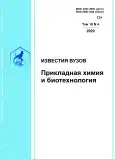Identification of a compound similar to triiodothyronine in the cells of higher plants
- 作者: Garipova M.I.1, Fedyaev V.V.1, Farkhutdinov R.G.1, Sotnikova J.M.1
-
隶属关系:
- Bashkir State University
- 期: 卷 10, 编号 4 (2020)
- 页面: 639-646
- 栏目: Physico-chemical biology
- URL: https://bakhtiniada.ru/2227-2925/article/view/299587
- DOI: https://doi.org/10.21285/2227-2925-2020-10-4-639-646
- ID: 299587
如何引用文章
全文:
详细
作者简介
M. Garipova
Bashkir State University
Email: margaritag@list.ru
V. Fedyaev
Bashkir State University
Email: vadim.fedyaev@gmail.com
R. Farkhutdinov
Bashkir State University
Email: frg2@mail.ru
J. Sotnikova
Bashkir State University
Email: sotnikova-bashedu@mail.ru
参考
- Mondal S., Mugesh G. Novel thyroid hormone analogues, enzyme inhibitors and mimetics, and their action // Molecular and Cellular Endocrinology. 2017. Vol. 458. P. 91-104. https://doi.org/10.1016/j.mce.2017.04.006
- Clouse S.D. Brassinosteroid Signal transduction: from receptor kinase activation to transcriptional networks regulating plant development // The Plant Cell. 2011. Vol. 23. Issue 4. P. 1219-1230 https://doi.org/10.1105/tpc.111.084475
- Куракин Г.Ф., Лопина Н.П., Бордина Г.Е Анализ механизма действия жасмонатов мето дами вычислительной химии // Вопросы биологической, медицинской и фармацевтической химии. 2018. Т. 21. N 4. С. 23-29. https://doi.org/10.29296/25877313-2018-04-05
- Gancheva M.S., Malovichko Y.V., Po-liushkevich L.O., Dodueva I.E., Lutova L.A. P // Russian Journal of Plant Physiology. 2019. Vol. 66. Issue 2. P. 171-189. https://doi.org/10.1134/S1021443719010072
- Lima S.T.C., Merrigan T.L., Rodrigues E.D. Synthetic and plant derived thyroid hormone analogs. In: Ward L.S. (edited). Thyroid and parathyroid diseases - new insights into some old and some new issues. In Tech, 2012. Chapter 15. P. 221-235. https://doi.org/10.5772/35134
- Kester M.H.A., de Mena R.M., Obregon M.J., Marinkovic D., Howatson A., Visser T.J., et al. Iodothyronine levels in the human developing brain: major regulatory roles of iodothyronine deiodinases in different areas // The Journal of Clinical Endocrinology & Metabolism. 2003. Vol. 89. Issue 7. P. 31173128. https://doi.org/10.1210/jc.2003-031832
- Bianco A.C., Maia A.L., da Silva W.S., Chris-toffolete M.A. Adaptive activation of thyroid hormone and energy expenditure // Bioscience Reports. 2005. Vol. 25. Issue 3-4. P. 191-208, https://doi.org/10.1007/s10540-005-2885-6
- Marsili A., Zavacki A.M., Harney J.W., Larsen P.R. Physiological role and regulation of iodothyronine deiodinases: a 2011 update // Journal of Endocrinological Investigation. 2011. Vol. 34. Issue 5. P. 395-407. https://doi.org/10.1007/BF3347465
- Giammanco M., di Liegro C.M., Schiera G., di Liegro I. Genomic and non-genomic mechanisms of action of thyroid hormones and their catabolite 3,5-diiodo-l-thyronine in mammals // International Journal of Molecular Sciences. 2020. Vol. 21. Issue 11. P. 4140-4149. https://doi.org/10.3390/ijms21114140
- Flamant F., Baxter J.D., Forrest D., Refetoff S., Samuels H., Scanlan T.S., et al. International union of pharmacology. LIX. The pharmacology and classification of the nuclear receptor superfamily: thyroid hormone receptors // Pharmacological Reviews. 2006. Vol. 58. Issue 4. P. 705-711. https://doi.org/10.1124/pr.58.4.3
- Anyetei-Anum C.S., Roggero V.R., Allison L.A. Thyroid hormone receptor localization in target tissues // Journal of Endocrinology. 2018. Vol. 237. Issue 1. P. R19-R34. https://doi.org/10.1530/JOE-17-0708
- Gupta A., Wamankar S., Gidwani B., Kaur C.D. Herbal drugs for thyroid treatment // International Journal of Pharmacy and Biological Sciences. 2016. Vol. 6. Issue 1. P. 62-70.
- Bharthi V., Shubhashree M., Bhat S. Herbal approach to management of thyroid disease - a review // Journal of Ayurvedic and Herbal Medicine. 2017. Vol. 3. Issue 1. P. 48-52.
- Zeng X., Yuan Y., Wu T., Yan L., Su H. Chinese herbal medicines for hyperthyroidism // Cochrane Database of Systematic Reviews. 2007. Issue 2. Article CD005450. https://doi.org/10.1002/14651858.CD005450.pub2
- De Souza dos Santos M.C., Gongalves C.F.L., Vaisman M., Ferreira A.C., de Carvalho D.P. Impact of flavonoids on thyroid function // Food and Chemical Toxicology. 2011. Vol. 49. Issue 10. P. 2495-2502. https://doi.org/10.1016/j.fct.2011.06.074
- Gongalves C.F.L., de Freitas M.L., Ferreira A.C.F. 'Flavonoids, thyroid iodide uptake and thyroid cancer - a review // International Journal of Molecular Science. 2017. Vol. 18. Issue 6. P. 1247-1252. https://doi.org/10.3390/ijms18061247
- Garipova M.I., Shigapova A.I., Farkhutdinov R.G., Fedyaev V.V., Sotnikova J.M., Yakupova A.B. The distribution of 3,5,3-triiodothyronine between the transport systems of blood and nuclei of the tissues // Journal of Biomolecular Structure and Dynamics. 2019. Vol. 37. Issue S1. P. 43-44. https://doi.org/10.1080/07391102.2019.1604468
- Bouquin T., Meier C., Foster R., Nielsen M.E., Mundy J. Control of specific gene expression by gibberellin and brassinosteroid // Plant Physiology. 2001. Vol. 127. Issue 2. P. 450-458. https://doi.org/10.1104/pp.010173
- Кефели В.И. Природные ингибиторы роста и фитогормоны. М.: Наука, 1974. 253 c.
- Hilker M., Schwachtje J., Baier M., Balaza-deh S., Baurle I., Geiselhardt S., et al. Priming and memory of stress responses in organisms lacking a nervous system // Biological Reviews of the Cambridge Philosophical Society. 2016. Vol. 91. Issue 4. P. 1118-1133 https://doi.org/10.1111/brv.12215
补充文件









